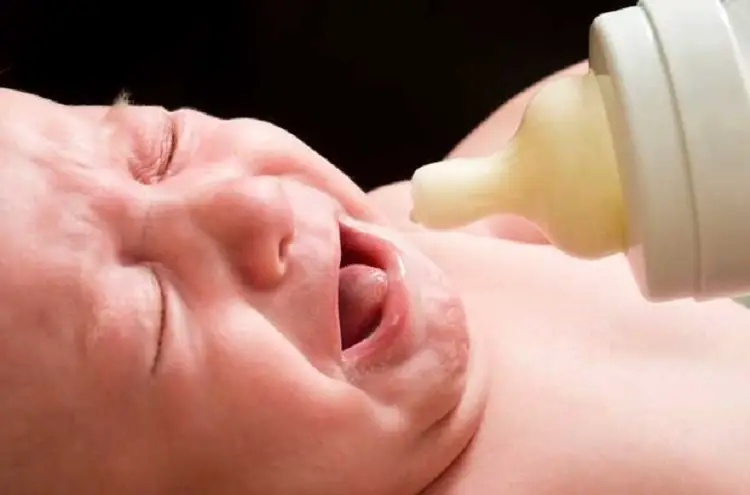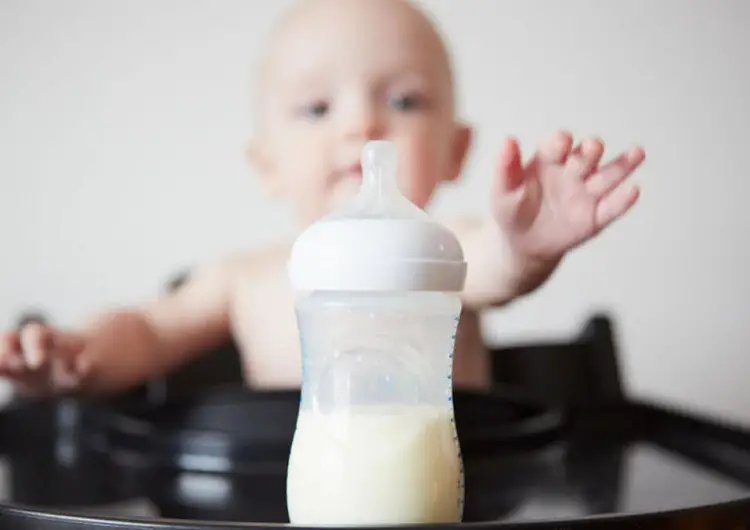Naturally, as your little one grows and begins to develop a certain personality, a lot will change about how you adapt to all that. One of the real struggles a lot of parents face is learning how to make formula taste like breast milk to encourage a smooth transition to formula.
Many parents have experienced rough transitioning from breast milk to formula with their babies and this may be due to certain factors such as taste and sometimes smell.
Don’t worry, we are here to help reduce the frustration and teach you some real and effective solutions to try to make feeding time a lot easier and more fun. After all, feeding your baby shouldn’t be a struggle.
In this article, we discuss the questions of why your baby doesn’t like the taste of formula, how to make formula taste like breast milk, factors to keep in mind if the baby doesn’t like the formula, and other formula feeding-related questions.
Why Your Baby Doesn’t Like The Taste Of Formula?

Your baby may reject the formula because of the taste. Some of them have a metallic taste or may taste bad generally. This is one major factor that can make transitioning from breast milk to formula difficult.
If you haven’t tasted baby formula before, you should give it try. Some of them can taste so bad which will prompt your baby to make a disgusted face and refuse to swallow the formula.
This bad taste may be attributed to the ingredients used in producing them. This is why a lot of mom’s especially first-time moms want to know how to make formula taste like breast milk for their babies.
Other Factors That Can Make Baby Reject the Formula
1. It Doesn’t Taste Close To Breast milk
This is another major reason why your baby may reject the formula. Assuming you are returning to work all stressed and you decide to switch from breast milk to formula.
Your baby is probably able to differentiate between formula and the real stuff, as much as you’re trying to make the formula last. All you need to do is look for formulas that taste closest to breast milk. Some of these formula brands taste very similar to breast milk and you can find them here:
2. It Makes Their Tummy Upset
Another reason why your baby may dislike the formula may be because of the way it makes them feel. If your baby is used to breastfeeding, transitioning to a bottle won’t be that easy.
Formula-fed babies are prone to be gassier and this could be as a result of ingestion of excess air while bottle feeding. It could also be the type of formula you’re using, which tends to prove difficult to break down in their digestive system or maybe both.
There are some baby formula brands like the Enfamil Gentlease recommended for gassy babies that offer blends formulated to be gentler on your baby’s digestive system.
Read Also: What To Eat To Prevent Gas While Breastfeeding (9 Foods To Avoid)
How To Make Formula Taste Like Breast Milk

Most people usually go with the idea of adding supplements or anything to improve the taste of the formula.
Well, this is not always the best idea due to several risks such as exposing your baby to sugar too early, the risk of infant obesity, and the risk of choking.
While being aware of these risks, here are a few steps you can try to make formula taste like breast milk for your baby.
1. Add breast milk
Research has proven that some moms who still have expressed milk or who can express milk add their breast milk to the formula while preparing baby food. This helps improve the taste and brings about a familiar base for the baby to ingest.
As recommended breast milk should be fed separately from formula rather than mixing the two, however always seek advice from an expert or your Pediatrician before mixing breast milk in formula preparation.
2. Use sterile milk
The kind of milk you use with your baby formula plays a huge role in its overall taste during preparation. So try and make a wise choice since it can affect and improve the formula taste.
Using sterile milk has proven to be a preventive measure against cross-contamination since it also allows your baby to have a complete nutritious meal every feeding time.
3. Use half-and-half
If your baby is rejecting the formula because of the taste, try the half and half trick. This technique is very effective when you have transitioned from one formula to another and your baby isn’t accepting of the new formula taste.
You can mix the former with the one you are using presently until you become comfortable with the taste again.
In summary, we mean getting half scoops of the old formula you need and a half scoop of the new formula to make up the rest. Do not forget to get approval from your baby’s pediatrician to use this technique continuously.
4. Ensure you are not overheating
The way you heat your baby formula can affect its overall taste. Try not to use a microwave for heating; doing so will make the formula lukewarm portions and very hot portions.
Alternatively, use the bottle warmer to warm your baby’s formula, this method has worked better for parents since it uses steam which is gradually and evenly distributed throughout the formula.
5. Mix properly
When preparing baby formula, make sure you swirl to mix and avoid shaking vigorously because it leads to the formation of bubbles that may cause stomach issues for your baby.
6. Get help
Sometimes you may need to transition from breast milk to formula due to health or personal reasons, and during this period you will need help with the baby.
While your baby’s taste buds are still underdeveloped and they will likely adjust to the new meal in a short while, it is important to distance yourself from the baby during mealtime.
This is because babies can perceive breast milk when the mother is close to them and may refuse to take the formula because of it.
7. Be patient
Rushing into something new that your baby hasn’t ever tasted to make him/her feed is ill-advised. Since most formula companies have already added certain ingredients to sweeten their product, it is best advised not to put any other additives in your baby formula.
Be patient, and see if your baby adjusts naturally to the formula, if he/she doesn’t then seek advice from your pediatrician.
Read Also: Best Formula For Picky Breastfed Babies
Factors To Keep in Mind If Your Baby Doesn’t Like The Formula
1. Bottle Type
Most moms may think that when their baby rejects the bottle, they feel the problem is from the content of the bottle when it could be the bottle itself. Some feeding bottles are really difficult for babies to eat from and can make babies uncomfortable and frustrated.
So don’t be in a rush to change the formula, try to look at the bottle first and see if something about it can be improved.
Read Also: When To Switch Nipple Bottle Size
2. Carefully follow the instructions
The procedures required for proper preparation are on the formula pack. This is so designed to ensure you get the right texture and concentration for your baby. This ensures you get the best out of every feed.
Make use of the scoop that the formula came with and make sure you don’t scoop over the level or under the level when preparing baby formula. Also, ensure you add the formula to water and not the other way round, and also ensure that you don’t over-dilute your baby’s formula.
3. Watch out for fluorine levels
Babies get fluorine from their formula and also from the water used in preparing the formula be it tap water or bottled water.
To avoid fluorosis, some parents and caregivers make use of deionized and distilled water which is a good choice if your baby gets fluorine from other sources.
To ensure that you use the right water for your little one, always consult with your health care provider for professional advice.
4. Baby’s Age
Aside from the baby formula itself, always take into account the age and stage of your baby. After the 5-month mark, you can begin introducing solid foods to your baby. Your rejecting the formula may be an indication they’re ready for other flavors, textures, and more substantial foods.
5. Don’t be abrupt
Try not to change things too quickly with the baby, be patient and make it as gradual as possible. Unless there are real health concerns about the use of certain formula or milk, take your time when changing the formula.
Alternatively, you can practice the ‘half and half’ method where you mix some of the old formulae your baby is used to with the new formula you are trying out to introduce the taste.
Doing this, I bet you there won’t be a total rejection of the new one when you finally begin to use it alone on your baby.
6. Offer baby the best tasting formula
As mentioned earlier, one of the major reasons why some babies dislike new formula taste is because of the bad taste. Try and make use of these formulas that taste closest to breast milk like the Gerber good start infant formula, Enfamil Prosobee Infant Formula, and Similac Isomil Infant Formula.
Related Articles:
- What Happens If Baby Drinks Spoiled Formula
- What To Do With An Old Breast Pump
- How To Store Formula Milk For Night Feeds
- Baby won’t Drink Pumped Milk (7 Helpful Tips)
- How Many Times Can You Reheat Formula? Find Out!
- Why Does Milk Turn Yellow When Frozen? Find Out!
Other Formula Feeding Related Questions
Can You Mix Formula and Breast Milk?
When babies are so used to breastfeeding it can be quite difficult to switch to formula. There is nothing wrong with mixing formula and breast milk. Mixing both can make your baby take formula easier as if they taste something familiar.
This doesn’t have to be a permanent solution and since breast pumping is quite a lot of work, and if you are transitioning to formula, try to get away from pumping or breastfeeding altogether.
Combining baby formula with your milk can be a great transitional process. It helps introduce the taste of formula gradually, hence reducing the breast milk until your baby gets used to taking formula.
How Long Will It Take For Baby To Transition To Formula?
Once you’ve decided to transition to formula from breast milk or you change the type of formula you are using, you need to be patient. Usually, babies take some time to adapt to something new, so be patient and try not to rush it.
Usually, it takes around 2-6 weeks for your baby to fully make this transition and get used to what you are giving them regularly.
Conclusion
We hope this article has given an in-depth knowledge to answer the question of how to make formula taste like breast milk. We know, it can be a daunting task and even a little frustrating when your little one hates the taste of the formula you offering.
Of course, as a concerned parent, you want the best for your child, and when you can’t get them to feed, you may feel sad and discouraged.
Don’t be discouraged, the key is to be patient in everything that you introduce to your baby, do not rush, and do not expect your baby to adjust immediately, take it one day at a time. Have you tried any one of the seven tips we listed above? Let us know by dropping a message.
